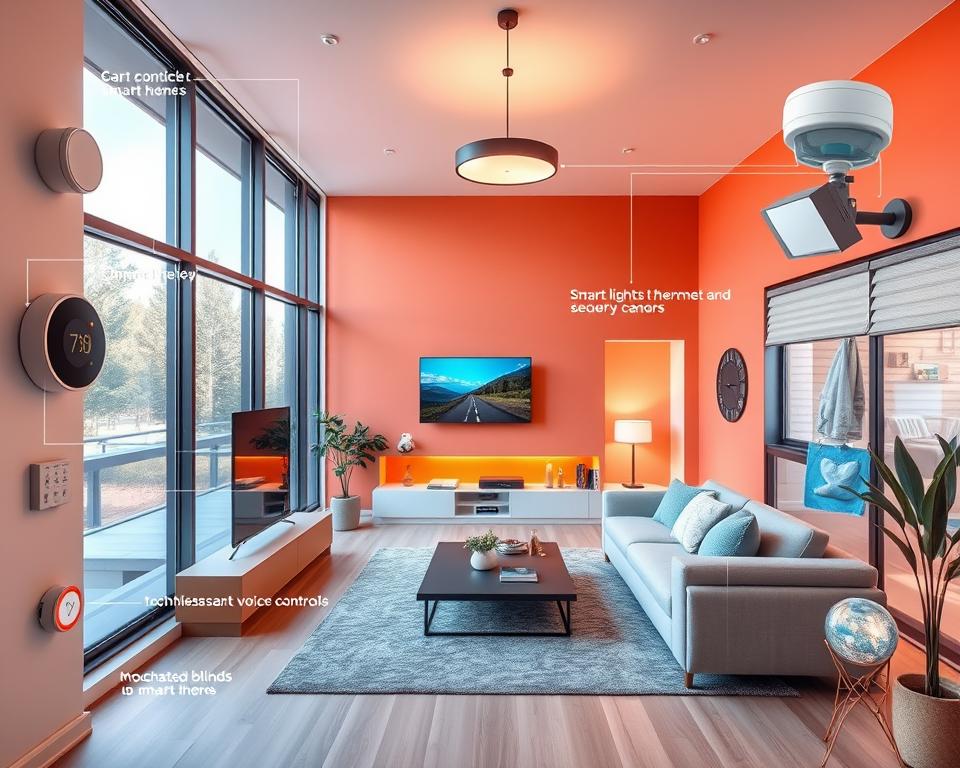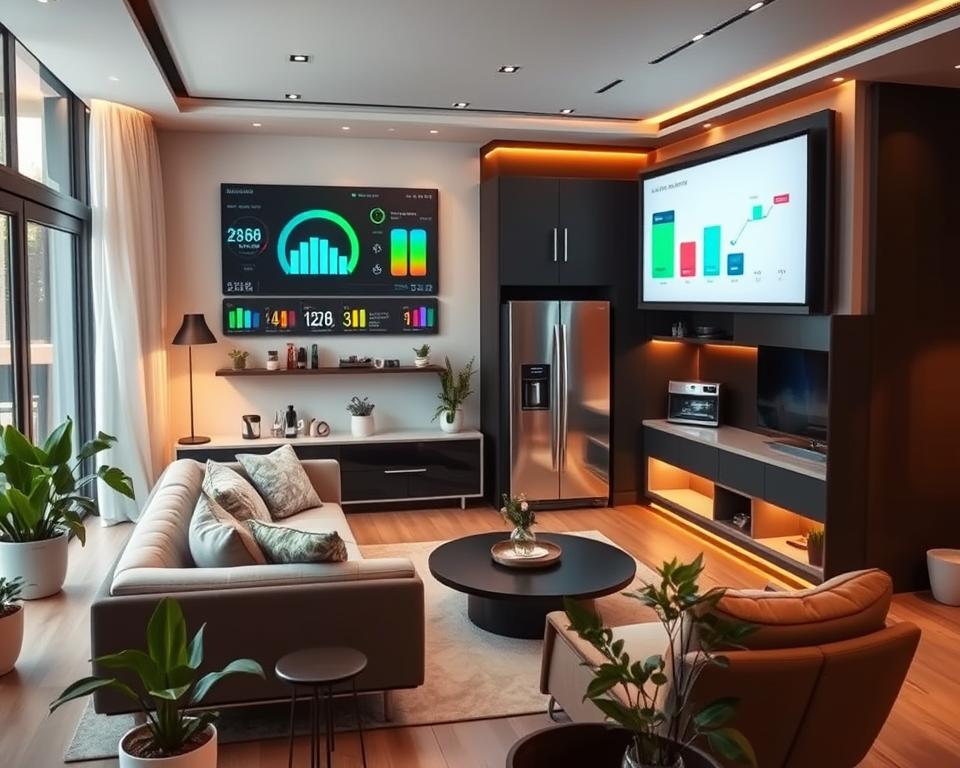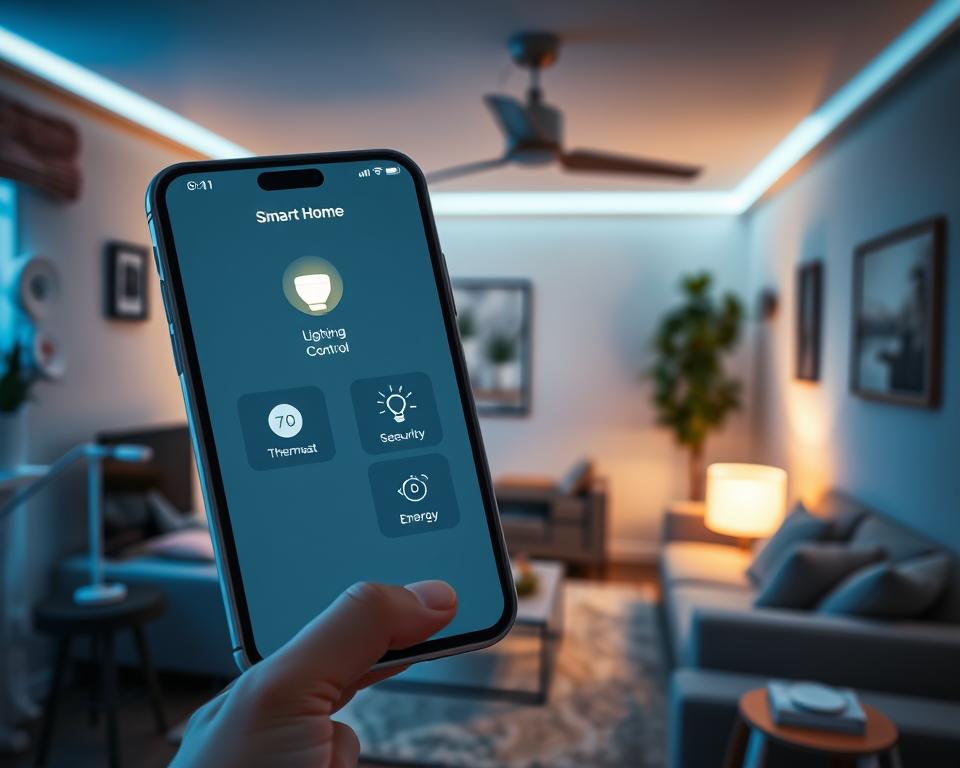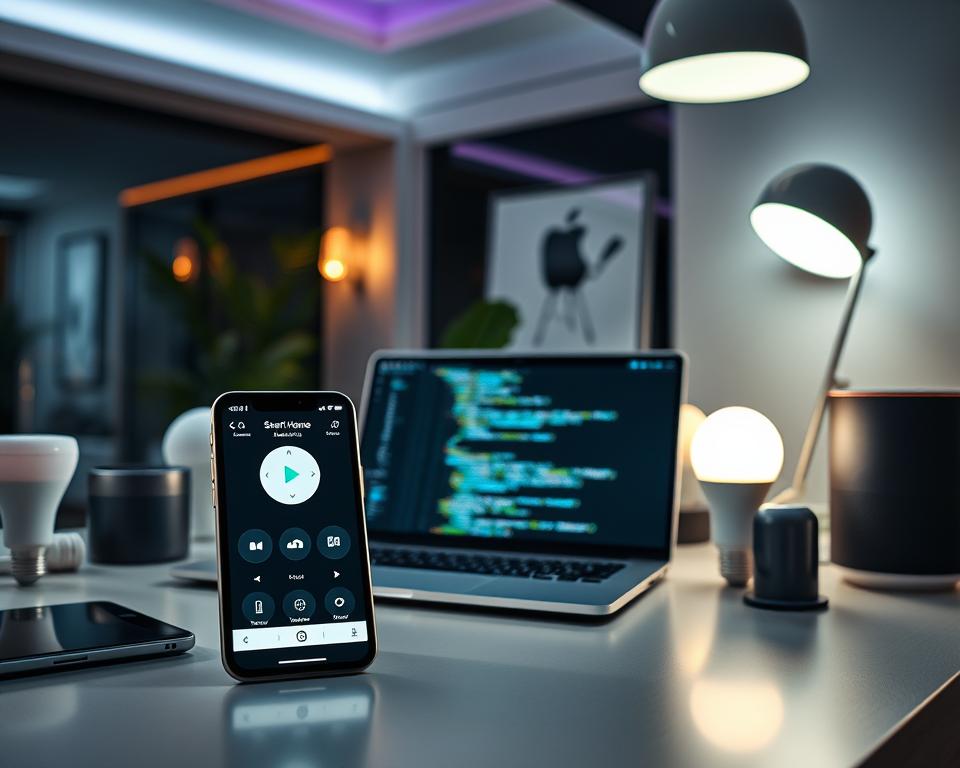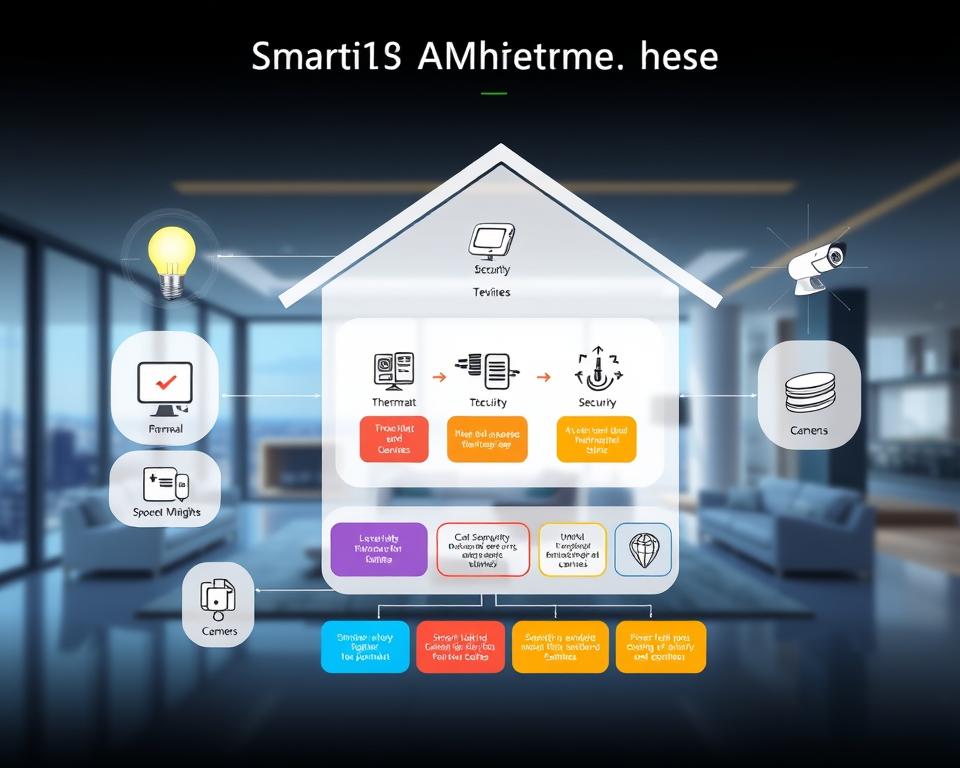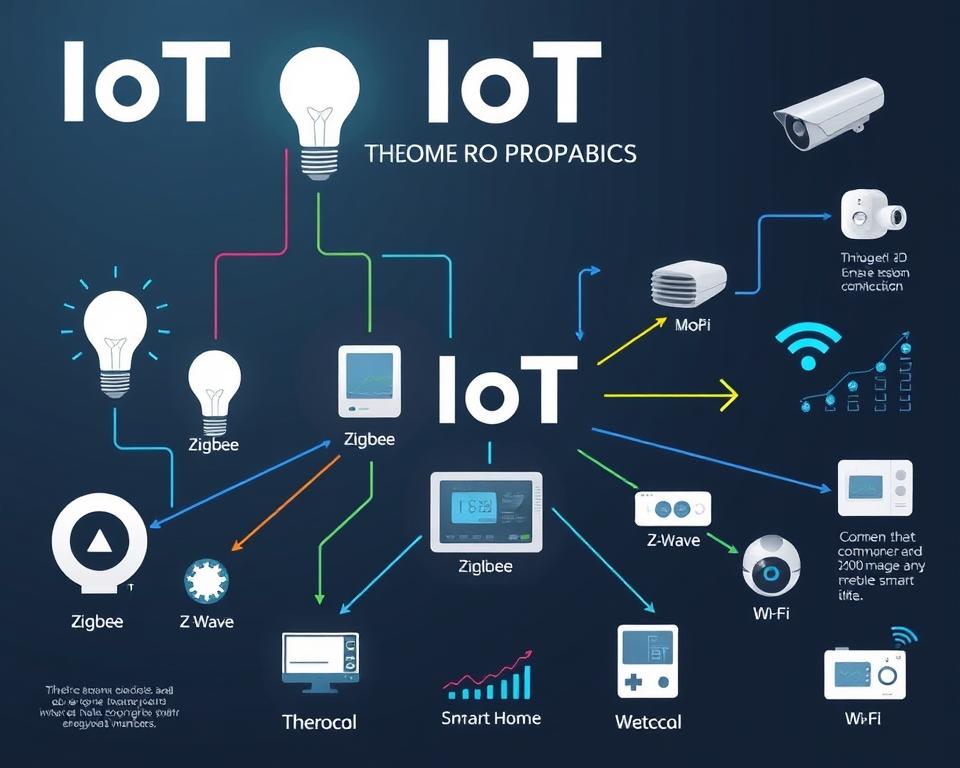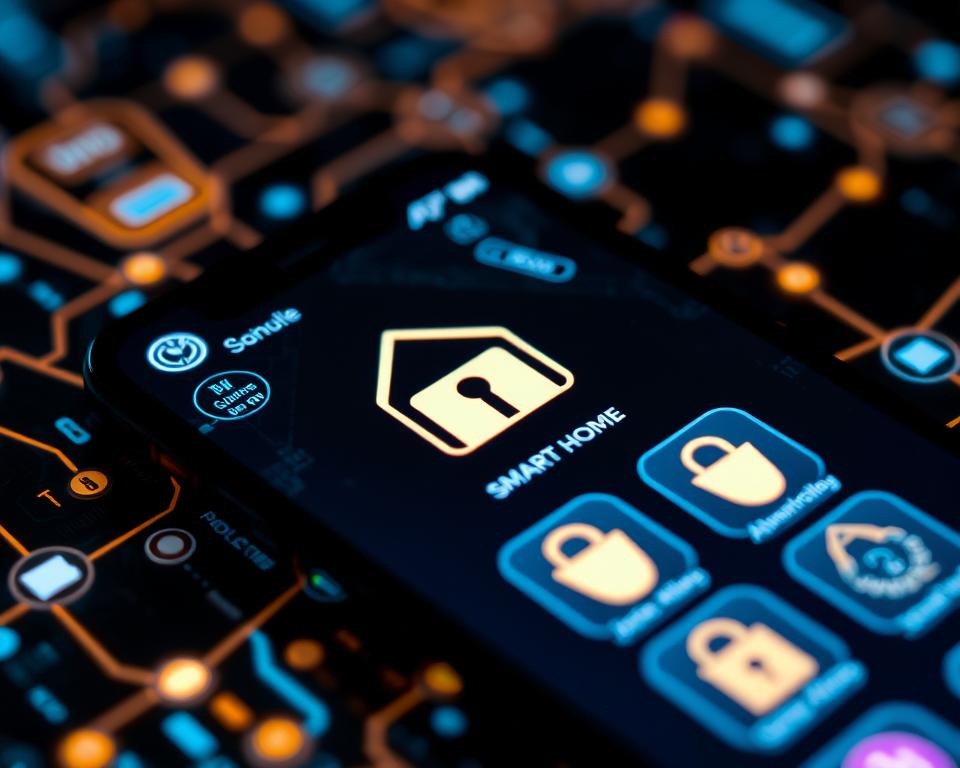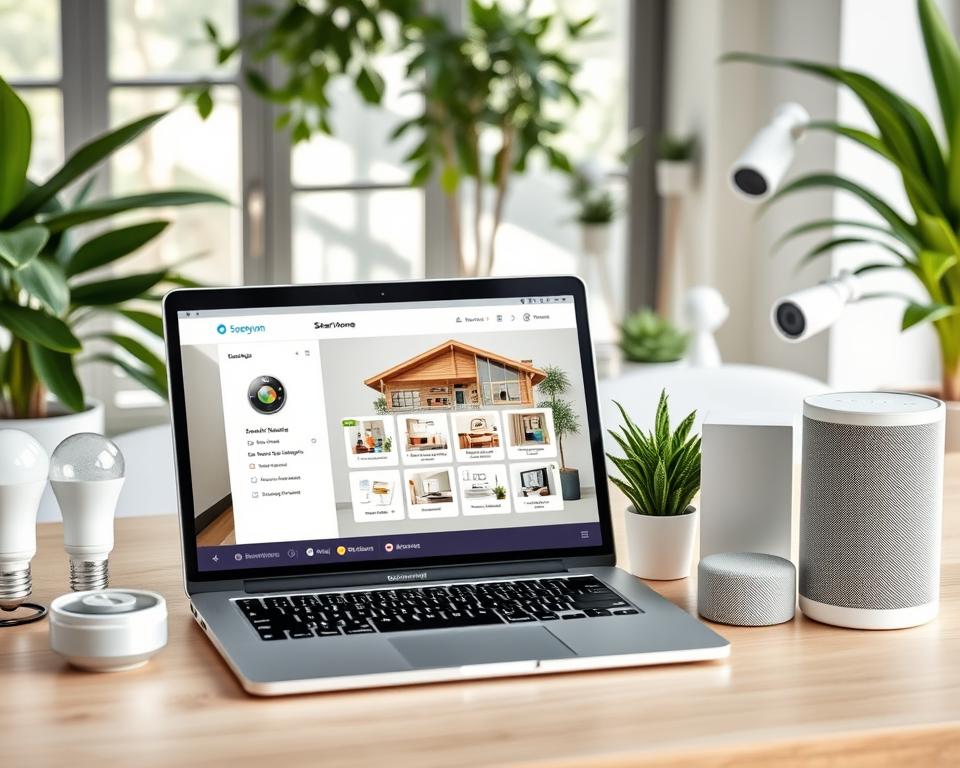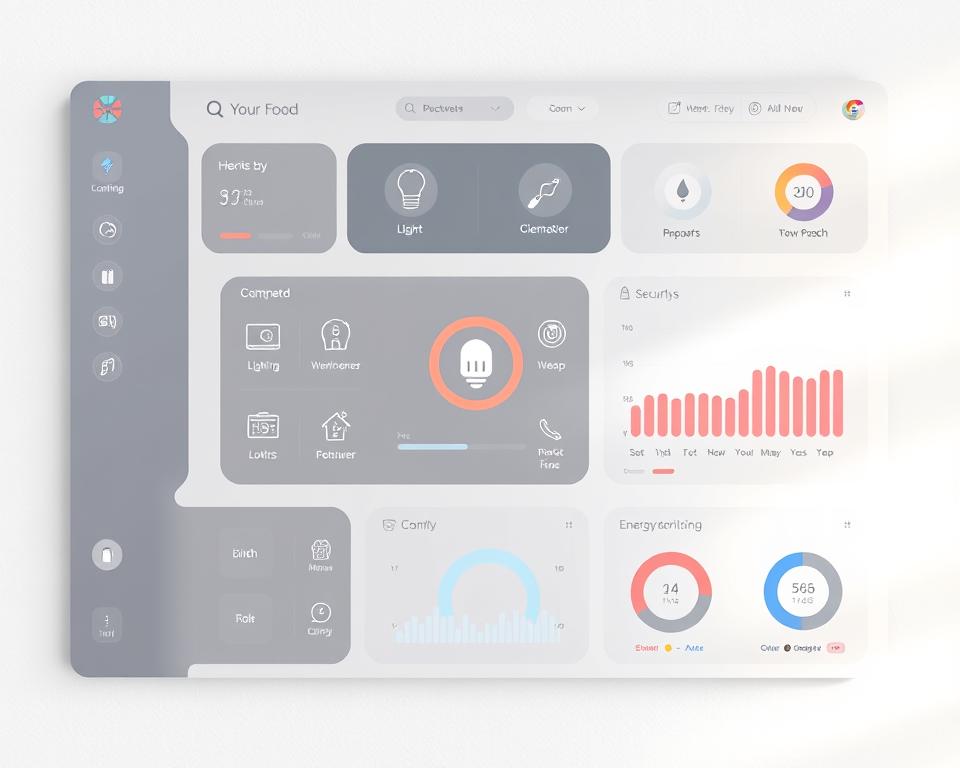The world of technology is always changing, and smart home automation is a big part of that. People want to control their homes easily and seamlessly. Creating an app that works with all smart home devices is key to making this happen.
The smart home market is growing fast, with a 15% annual growth rate expected until 2030. This growth comes from more people using smart devices like speakers, lights, security systems, and climate controls. A single app that can manage all these devices makes life easier and more efficient.
Having a smart home app is not just about convenience. It can also help save energy and money, and make homes safer. With voice control and AI, using these apps becomes even simpler and more fun.
Table of Contents
Key Takeaways
- The smart home automation market is experiencing rapid growth, driven by the increasing adoption of connected devices and the demand for seamless control.
- Developing a comprehensive app that can integrate various smart home systems is crucial for unlocking the full potential of IoT technology.
- A smart home automation app can provide benefits such as improved energy efficiency, cost savings, and enhanced security through remote monitoring and control.
- Incorporating voice-controlled and AI-powered features can enhance the user experience and make home automation more intuitive.
- Designing a user-friendly and feature-rich app is essential to meet the evolving needs of smart home consumers.
Understanding Smart Home Automation Fundamentals
The smart home ecosystem is a complex network of devices, sensors, and technologies. It works together to make our homes more convenient, energy-efficient, and secure. At the heart of this system are sensors, actuators, and hubs.
Core Components of Smart Home Systems
Sensors are like the eyes and ears of the smart home. They collect data on temperature, humidity, motion, and light levels. Actuators are the muscles, turning digital commands into actions like turning on lights or adjusting the thermostat.
The hub, or the “brain,” is the central control unit. It connects and coordinates devices, making sure they work together smoothly in the smart home ecosystem.
Key Protocols and Standards
The smart home industry uses IoT protocols and wireless standards like Zigbee, Z-Wave, and Wi-Fi. These rules help devices talk to each other, making the smart home ecosystem work together.
Communication Technologies Overview
- Zigbee: A low-power, mesh networking protocol for devices needing less bandwidth and energy.
- Z-Wave: A proprietary wireless communication standard for reliable, low-latency home automation.
- Wi-Fi: A widely used wireless communication standard for high-bandwidth connectivity, great for multimedia and cloud-connected devices.
Knowing the core components and communication technologies is key. It helps in creating apps and solutions that can control and integrate devices in the smart home ecosystem.
Market Analysis and Target Audience Research
Understanding the smart home market trends and knowing who to target is key for a successful app. By studying the market and what people want, developers can make apps that meet those needs. This helps them reach the right user demographics.
The global smart home market is growing fast. This is because more people are using connected devices and smart home tech is getting better. The demand for energy-saving and easy-to-use home automation is also rising. Experts think the market will keep growing, with a growth rate of over 15% in the next few years.
When it comes to what people want, who they are matters a lot. Younger people, like millennials and Gen Z, are more into smart home tech. They look for apps that are easy to use, connect well, and keep their data safe.
| Smart Home Market Trends | Consumer Preferences | User Demographics |
|---|---|---|
| Rapid growth, projected CAGR of over 15% | Ease of use, seamless connectivity, data privacy | Millennials and Gen Z with higher adoption rates |
By knowing these trends and what people want, app developers can make apps that meet their needs. This can help engage users and make the app successful in the market.
“The smart home market is poised for exponential growth, with tech-savvy millennials leading the charge in adopting these innovative solutions.”
Essential Features for Smart Home Integration Apps
The smart home revolution is changing how we live. Now, apps that control our homes are more important than ever. These apps let us manage our devices easily, making our homes smarter.
Device Discovery and Pairing
Finding and linking devices in the app is key. Users should be able to connect their smart home gadgets quickly. This includes smart devices, appliances, and sensors, without needing to be tech experts.
User Interface Requirements
The design of these apps is crucial. They need to be easy to use and look good. A well-designed app lets users control their devices smoothly, making their smart home experience better.
Security Implementation Guidelines
Keeping user data safe is a top priority. Smart home apps must protect our privacy and keep our devices secure. They use encryption and follow data privacy rules to keep our homes safe.
“Developing a smart home integration app that seamlessly connects devices, offers an intuitive user interface, and prioritizes security is the key to unlocking the full potential of smart home technology.”
Selecting the Right Development Platform
Creating a smart home app needs a good look at the mobile app development platforms. There are many choices, like native iOS and Android apps, cross-platform frameworks, and web-based apps.
Native apps are made just for iOS or Android. They work well and use special features of each platform. But, they need a big team and take longer to make because they’re kept separate for each system.
Cross-platform frameworks like React Native or Flutter let you make one app for both iOS and Android. This saves time and money, making it a popular choice for smart home apps.
Web-based apps, like Progressive Web Apps (PWAs), work on many platforms and are easy to put out there. But, they might not perform as well as native apps and can’t use all native device features.
When picking a platform, think about how well it works, how it scales, how long it takes to make, and if it works on different platforms. This ensures your smart home app fits the project’s needs and what users want.
“Choosing the right mobile app development platform is crucial for the success of your smart home integration app. The platform you select will impact the app’s performance, user experience, and long-term maintainability.”
Planning Your App Architecture and Database Design
Creating a smart home app needs careful planning. You must think about the app’s architecture and database design. A strong, scalable infrastructure is key to handle more devices and users.
Data Models and Relationships
The app’s foundation is its data models and relationships. These define how information is stored and accessed. You need to plan the entities, like devices and users, and how they connect. A good database schema improves data access and reduces redundancy.
API Structure Planning
The API structure is vital for your app’s architecture. It connects your app to smart home devices, enabling communication and data exchange. Planning API endpoints, data formats, and authentication is crucial for future growth and new device integration.
Scalability Considerations
As more users and devices join, scalability is key. Designing your app and database for scalability ensures they can grow without performance issues. Strategies like load balancing and caching help your app scale smoothly.
By planning your app’s architecture and database, you lay a solid foundation. This supports smart home automation needs, offering a reliable experience for users.
IoT Protocol Implementation Strategies
Choosing the right IoT communication protocols is vital for a smart home app. Options like MQTT, CoAP, HTTP, and WebSocket each have their own benefits. Knowing their strengths and weaknesses helps create a top-notch smart home solution.
MQTT is great for devices that use little power. It’s fast and reliable, perfect for smart homes that need quick communication.
CoAP is designed for simple, web-like communication. It works well with HTTP, making it easy to integrate with web services in smart homes.
HTTP is well-known but might not be the best for all IoT needs. Still, its wide use and support for web tech make it good for apps that need cloud integration.
WebSocket offers real-time updates, which is key for smart homes. It’s fast, making it ideal for instant actions like voice commands or alerts.
Developers must consider the smart home’s needs, device capabilities, and user wants when choosing protocols. By using each protocol’s strengths, they can make a smart home app that’s seamless and efficient.
User Authentication and Security Measures
In the world of smart home automation, keeping your data safe is key. As we connect our homes with devices, protecting our personal info is crucial. This section talks about app security, data encryption, access control, and following data protection laws like GDPR.
Encryption Methods
Data encryption is at the core of app security. It keeps your info safe from hackers. Smart home apps use strong encryption like AES and RSA to protect your data. This makes your app use safe and trustworthy.
Access Control Systems
Access control systems are vital for app security. They include multi-factor authentication and user permissions. These features stop unauthorized access and protect your data.
Data Privacy Compliance
Smart home apps must follow strict data protection laws, like GDPR. They need to be open about data use and get user consent. This builds trust and keeps the app in line with regulations.
| Security Measure | Description | Benefit |
|---|---|---|
| Data Encryption | Implementation of advanced encryption protocols (e.g., AES, RSA) to protect user data | Safeguards sensitive information from unauthorized access, enhancing user trust and privacy |
| Access Control Systems | Multi-factor authentication, user-level permissions, and role-based access control | Prevents unauthorized access and limits the potential for data breaches |
| Data Privacy Compliance | Adherence to data protection regulations (e.g., GDPR) through transparent policies and secure data practices | Builds user trust, demonstrates a commitment to data privacy, and ensures regulatory compliance |
By using these security steps, app developers make a safe space for users. This lets people enjoy smart home tech without worrying about their data.
Developing an App for Smart Home Automation Integration
Creating a smart home app needs a deep understanding of app development and coding. It also requires working well with smart home devices. We’ll look at the important steps and strategies for making a great smart home app.
Coding Best Practices for Smart Home Apps
Building a smart home app means following good coding practices. This makes the app stable, scalable, and easy to update. Key points include:
- Modular and scalable code architecture
- Adherence to industry-standard design patterns
- Efficient data handling and storage
- Robust error handling and exception management
- Continuous integration and deployment workflows
Seamless Integration with Smart Home Devices
Ensuring your app works well with many smart home devices is crucial. This means:
- Supporting various communication protocols, like Wi-Fi, Bluetooth, and ZigBee
- Creating a flexible API for adding new devices
- Designing easy device discovery and pairing
- Providing a consistent and easy-to-use experience
By focusing on best practices and integration, developers can make apps that improve the user’s experience. This makes home automation easy and enjoyable.
“The key to successful smart home app development lies in balancing cutting-edge technology with a laser-sharp focus on user needs and expectations.” – Jane Doe, Lead Developer at ABC Smart Home Solutions
Creating Intuitive User Interfaces for Home Control
Designing an intuitive and user-friendly interface is key for smart home apps. Homeowners want easy control over their devices. A good UI/UX makes a big difference in their experience.
By focusing on dashboard design and device control, developers can help users manage their smart homes easily.
Dashboard Design Principles
The dashboard is the heart of a smart home app. It should follow these design principles for a smooth user experience:
- Clean and organized layout with clear visual hierarchy
- Intuitive grouping and categorization of connected devices
- Prominent display of real-time status updates and alerts
- Easily accessible controls for common device actions
- Customizable views and personalization options
Device Control Interfaces
Controlling smart home devices smoothly is key for user happiness. Effective interfaces should have:
- Responsive and mobile-friendly design for on-the-go access
- Intuitive touch-based controls, such as sliders and toggle switches
- Visual feedback mechanisms to indicate device status and changes
- Streamlined navigation between connected devices
- Voice control integration for hands-free operation
By focusing on UI/UX design, smart home apps can offer a great home control experience. A well-designed dashboard and device control interfaces make these solutions more appealing and adopted.
Implementation of Real-time Updates and Notifications
In the world of smart home automation, it’s key to keep users updated on their devices. The app must use advanced tech for real-time updates and push notifications. This ensures your smart home app stays at the forefront.
Harnessing Push Notifications
Push notifications are vital for real-time communication in smart home apps. They alert users to important events like security breaches, energy usage spikes, or device malfunctions. This lets homeowners act fast, keeping them in control and at ease.
Embracing Real-time Data Streaming
Your app needs to handle real-time data streaming for a smooth user experience. This tech lets the app get and process data from devices constantly. Real-time data streaming is key to event-driven architecture, fitting well with smart home systems.
Implementing Event-driven Architecture
An event-driven architecture is at the core of your smart home app. It makes the app react fast to device events, like a motion sensor or door lock. This approach makes your app smart and responsive, keeping users informed and in charge.
“Real-time updates and notifications are the lifeblood of a successful smart home integration app. By seamlessly integrating these features, you empower users to stay connected and in control of their homes, even when they’re away.”
Testing and Quality Assurance Procedures
Creating a solid smart home app needs a detailed testing and quality assurance (QA) plan. This step is key to make sure the app works well on different devices and with various users. Let’s explore the main parts of testing and QA for your smart home app.
Integration Testing Methods
Good integration testing is vital to check if your app works well with different smart home devices. It checks if the app can find, connect, and talk to many IoT devices. By using strict testing methods, you can find and fix any problems early.
Performance Optimization
Performance testing is very important for smart home apps. Your app must handle data and control devices quickly and smoothly. Improve the app’s speed by finding and fixing slow spots, so users have a great experience.
User Acceptance Testing
The final test of your smart home app’s success is how well it meets user needs. Do thorough user acceptance testing (UAT) to get feedback and improve the app. Use a variety of users to check if the app is easy to use and valuable.
With a strong testing and QA plan, your smart home app will be solid, dependable, and offer a great user experience.
Device Compatibility and Integration Challenges
Smart home automation is growing fast. Now, making devices work together smoothly is key. App developers face big challenges in making this happen.
Ensuring devices from different systems work well together is hard. Smart home gadgets use their own ways to talk to each other. This makes it tough for users to control everything from one app.
Strategies for Enhancing Interoperability
- Use open standards like Wi-Fi, Bluetooth, and ZigBee to make devices work better together.
- Build flexible integration systems that can grow with new tech.
- Work with top smart home brands to make sure your app works with their products.
Addressing Integration Challenges
- Create strong troubleshooting tools to find and fix problems.
- Provide detailed guides and support to help users solve issues.
- Keep your app updated with the latest smart home tech.
| Challenge | Potential Solution |
|---|---|
| Fragmented smart home ecosystems | Adopt open standards and universal protocols |
| Varying device communication protocols | Implement flexible and extensible integration frameworks |
| Compatibility issues with new smart home devices | Continuously update your app to maintain compatibility |
“The key to successful smart home integration is to create a seamless and harmonious experience for users, regardless of the devices they choose to use.”
By tackling these issues, app makers can offer smart home solutions that meet user needs. They can make the experience smooth and easy for everyone.
Implementing Voice Control and AI Assistants
Smart home tech keeps getting better, with voice control and AI assistants leading the way. These features make life easier and more fun. Adding them to a smart home app makes it more appealing to tech lovers.
Voice Command Integration
Voice command lets users control their smart home with just their voice. It’s easy to change the temperature, turn on lights, or lock doors with voice commands. The app uses advanced tech to understand what you say and do what you want.
AI Learning Algorithms
AI in the app makes it smarter over time. It learns your habits and preferences to suggest better settings. For example, it might adjust the lights and temperature based on when you’re home or what time it is.
| Feature | Benefit |
|---|---|
| Voice Control | Hands-free, intuitive home management |
| AI Learning Algorithms | Personalized automation and smart recommendations |
With voice control and AI, the app becomes more natural and helpful. It makes your life easier and more enjoyable, keeping you happy with the app.
App Deployment and Maintenance Strategies
Launching a smart home integration app is just the beginning. To keep users happy and engaged, developers need to focus on app deployment and maintenance strategies. This means optimizing for the app store, using continuous integration for smooth updates, and offering top-notch user support.
Getting your app noticed on the app store is key. Good app descriptions, the right keywords, and high ratings can help a lot. It’s also important to listen to user feedback and fix problems fast.
Using continuous integration helps with software updates. These updates can add new features, improve the app, and solve user problems. By automating the update process, developers can keep the app running smoothly without any hiccups.
Finally, providing great user support is vital. Quick in-app help, detailed guides, and solving problems quickly can make users happy and loyal to your app.
| Strategy | Benefit |
|---|---|
| App Store Optimization | Improved discoverability and downloads |
| Continuous Integration | Seamless software updates and enhancements |
| Comprehensive User Support | Increased user satisfaction and retention |
By taking a complete approach to app deployment and maintenance, developers can keep their smart home integration app fresh and useful. This ensures it stays relevant and meets the changing needs of smart home users.
“Ongoing maintenance and support are crucial for the long-term success of any smart home integration app. Proactive and responsive strategies can help you stay ahead of user needs and technological advancements.”
Future-proofing Your Smart Home App
As IoT trends and smart home innovations grow, making your app future-proof is key. Anticipate new technologies and plan for growth. This way, your app stays relevant and adaptable in the changing world of home automation.
Emerging Technologies
The smart home world is changing fast. New tech like voice control, artificial intelligence, and advanced sensors are changing how we interact with our homes. Adding voice commands and AI can make your app better. It lets users control devices with voice and enjoy personalized automation.
Scalability Planning
More people are using smart home tech, so your app needs to grow with it. Good scalability planning is essential. This includes smart data models, flexible APIs, and cloud-based systems. These features help your app handle more users and devices easily.
| Emerging Technology | Key Benefits |
|---|---|
| Voice Control | Seamless hands-free control, natural user experience |
| Artificial Intelligence | Personalized automation, predictive learning, advanced analytics |
| Advanced Sensors | Improved device monitoring, enhanced home awareness |
By using new IoT trends and building a scalable app, you can lead in the smart home tech world. Your app will offer amazing user experiences and stay ahead of rivals.
Conclusion
Smart home integration apps are key as IoT and home automation grow. They connect homeowners to their devices, offering control, updates, and security.
Developers need to know the basics of smart home systems to make apps that work well with many devices. It’s also important to understand what homeowners want. This helps make apps that meet their needs.
The smart home market is growing fast. New tech like voice control and AI will make apps better. Developers must keep up with these changes to make apps that are useful and easy to use.








